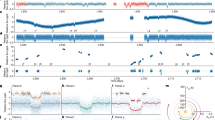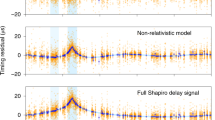Abstract
PERIODIC variations in the arrival times of pulses from the millisecond pulsar PSR1257+12 are most straightforwardly interpreted as indicating the presence of two planet-like companions orbiting the pulsar1. Rasio et al.2have proposed that the planetary explanation is amenable to a simple test: the deduced parameters put the planets near an orbital resonance, in which case secular evolution of the orbits should be observable in a matter of years. Detection of such orbital evolution would yield the masses and orbital inclinations of the planets. Here we point out that if the masses of the two planets are more than ∼10 times greater than the minimum values (3.4 and 2.8 Earth masses) allowed by the observations, then their orbits will be in an exact 3:2 resonance. The character of the predicted orbital parameter perturbations is then markedly different from the periodic perturbations that result from only a near-resonance. The amplitude of the perturbations is much greater, and is very sensitive to the planet masses.
This is a preview of subscription content, access via your institution
Access options
Subscribe to this journal
Receive 51 print issues and online access
$199.00 per year
only $3.90 per issue
Buy this article
- Purchase on Springer Link
- Instant access to full article PDF
Prices may be subject to local taxes which are calculated during checkout
Similar content being viewed by others
References
Wolszczan, A. & Frail, D. A. Nature 355, 145–147 (1992).
Rasio, F. A., Nicholson, P. D., Shapiro, S. L. & Teukolsky, S. A. Nature 355, 325–326 (1992).
Graziani, F. & Black, D. Astrophys. J. 251, 337–341 (1981).
Wisdom, J. Astr. J. 85, 1122–1133 (1980).
Everhart, E. in Dynamics of Comets: their Origin and Evolution (eds Carusi, A. & Valsecchi, G. B.) 185–202 (Reidel, Dordrecht, 1985).
Malhotra, R. thesis, Cornell Univ. (1988).
Peale, S. J. in Satellites (eds Burns, J. A. & Mathews, M. S.) (University of Arizona Press, 1986).
Schubart, J. Smithsonian Astrophys. Obs. Spec, Rep. No. 149 (1964).
Henrard, J. & Lemaitre, A. Cel. Mech. 30, 197–218 (1983).
Dermott, S. F., Malhotra, R. & Murray, C. D. Icarus 76, 295–334 (1988).
Author information
Authors and Affiliations
Rights and permissions
About this article
Cite this article
Malhotra, R., Black, D., Eck, A. et al. Resonant orbital evolution in the putative planetary system of PSR1257 + 12. Nature 356, 583–585 (1992). https://doi.org/10.1038/356583a0
Received:
Accepted:
Issue Date:
DOI: https://doi.org/10.1038/356583a0
This article is cited by
-
Dynamics of Two Planets in the 3/2 Mean-motion Resonance: Application to the Planetary System of the Pulsar PSR B1257+12
Celestial Mechanics and Dynamical Astronomy (2006)
Comments
By submitting a comment you agree to abide by our Terms and Community Guidelines. If you find something abusive or that does not comply with our terms or guidelines please flag it as inappropriate.



